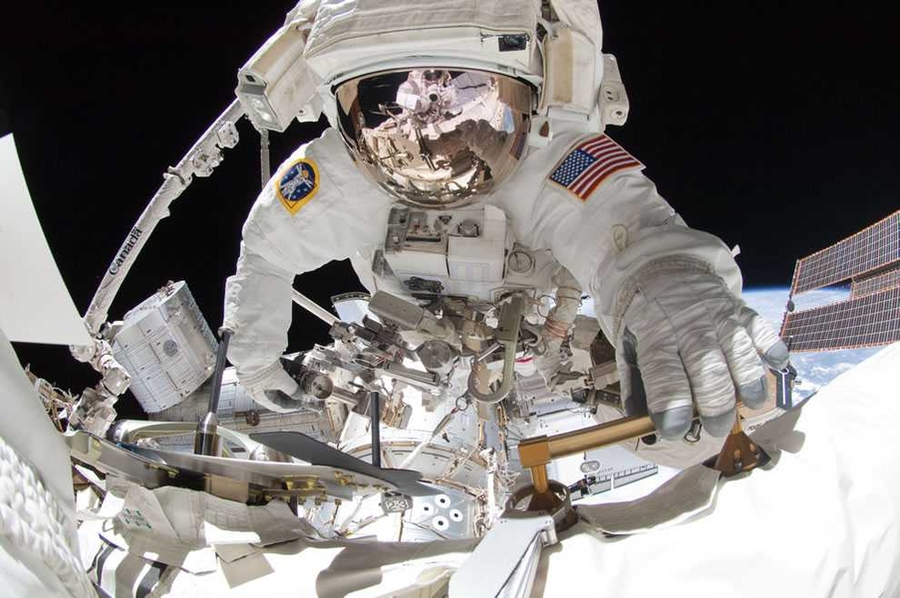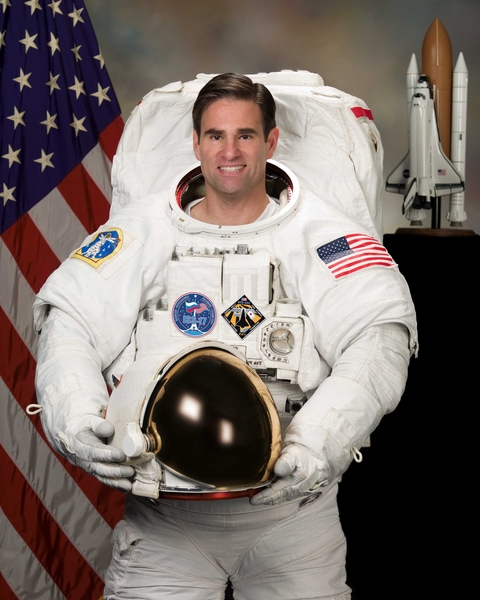On May 27, Space Shuttle Endeavour astronaut Greg Chamitoff PhD ’92 was part of the last-ever spacewalk by a space shuttle crew. The penultimate flight of the space shuttle program — followed in July by the final voyage of Space Shuttle Atlantis — also installed the Alpha Magnetic Spectrometer, a particle physics observatory, on the International Space Station to look for dark matter and clues to the beginnings of the universe. He talked with MIT News about some of his favorite moments as a space shuttle astronaut.
Q. You’ve been known to bring mementos up in space; rumor has it that you’re even responsible for introducing the first bagels in space. What are some other unique and unexpected mementos that space shuttle astronauts have brought up with them? And why do you think there’s this attraction to bringing mementos from Earth to space?
A. Astronauts are typically allowed a very small volume of personal items that they can bring to space. We also get a small allocation of space to bring a few things for organizations and individuals. There are a lot of constraints on what can fly. Nevertheless, quite a variety of items have made their way onboard. One of the most important … to me was to fly something that was meaningful for my kids. On my first mission, I brought up a puppet that we called Sammy the Skunk. My kids were only 3 and before the flight I had them 100 percent convinced it was a real animal. So it was great to be able to show them that Sammy was with me when I had a video-link with them once a week for six months. Especially for long [voyages], it’s nice to have personal items, such as family photos. I also brought favorite music and extra guitar strings so I could play along with a guitar we have up there. In that case, it’s considered psychological support!
Q. You’ve logged nearly 200 days in space, and you were part of the very last spacewalk for Space Shuttle Endeavour. What story or memory will most stick with you from that last mission to space?
A. I’m very lucky to have been part of the International Space Station program from the very beginning, when it was just PowerPoint slides, to the point of physically attaching the last bit of hardware as part of its assembly with my own hands. There was a very special moment during STS-134, the last flight of Endeavour, that I will never forget. During the fourth spacewalk we had climbed high up on a platform called ELC-3 on the truss. You can’t climb any higher, and the view from there was just breathtaking. This was right at the end of the very last spacewalk for the construction of the space station. We watched a spectacular sunrise from up there and then gazed at this marvelous achievement of 15 countries and 12 years of work together. To see the entire space station below us, and the Earth further below, and share that moment with all the flight control centers around the world — it was an intensely emotional moment. We did it, all of us, and at that moment we were flying high above the most amazing things humans have ever built. From there it seemed that the future was within reach.
Q. The space shuttle has become an iconic image for human space exploration, and the astronaut has become synonymous with “spacewalker.” Now that the shuttle program is officially retired, how might the role of the American astronaut change? And where do you see humans exploring next?
A. The meaning of the “right stuff” has changed, and as more people live and work in space we will be able to specialize more and more. For me, with two Russian colleagues, I was an engineer, science officer, medical technician, public affairs person and repair handyman. In the future we’ll be able to have a doctor work as a doctor and a scientist work in their specialty most of the time. But for the next decade or two we’ll still need everyone to know something about everything. We will soon be leaving Earth’s orbit again to explore destinations further and further away. This will be a very exciting time to be alive. No doubt everywhere we go we’ll be seeing and experiencing amazing new things while we learn about the universe in which we live. I wish it could all happen so much faster, but I believe it is inevitable and that soon enough there will be colonies throughout our solar system and people on the way to other stars.
Q. You’ve been known to bring mementos up in space; rumor has it that you’re even responsible for introducing the first bagels in space. What are some other unique and unexpected mementos that space shuttle astronauts have brought up with them? And why do you think there’s this attraction to bringing mementos from Earth to space?
A. Astronauts are typically allowed a very small volume of personal items that they can bring to space. We also get a small allocation of space to bring a few things for organizations and individuals. There are a lot of constraints on what can fly. Nevertheless, quite a variety of items have made their way onboard. One of the most important … to me was to fly something that was meaningful for my kids. On my first mission, I brought up a puppet that we called Sammy the Skunk. My kids were only 3 and before the flight I had them 100 percent convinced it was a real animal. So it was great to be able to show them that Sammy was with me when I had a video-link with them once a week for six months. Especially for long [voyages], it’s nice to have personal items, such as family photos. I also brought favorite music and extra guitar strings so I could play along with a guitar we have up there. In that case, it’s considered psychological support!
Q. You’ve logged nearly 200 days in space, and you were part of the very last spacewalk for Space Shuttle Endeavour. What story or memory will most stick with you from that last mission to space?
A. I’m very lucky to have been part of the International Space Station program from the very beginning, when it was just PowerPoint slides, to the point of physically attaching the last bit of hardware as part of its assembly with my own hands. There was a very special moment during STS-134, the last flight of Endeavour, that I will never forget. During the fourth spacewalk we had climbed high up on a platform called ELC-3 on the truss. You can’t climb any higher, and the view from there was just breathtaking. This was right at the end of the very last spacewalk for the construction of the space station. We watched a spectacular sunrise from up there and then gazed at this marvelous achievement of 15 countries and 12 years of work together. To see the entire space station below us, and the Earth further below, and share that moment with all the flight control centers around the world — it was an intensely emotional moment. We did it, all of us, and at that moment we were flying high above the most amazing things humans have ever built. From there it seemed that the future was within reach.
Q. The space shuttle has become an iconic image for human space exploration, and the astronaut has become synonymous with “spacewalker.” Now that the shuttle program is officially retired, how might the role of the American astronaut change? And where do you see humans exploring next?
A. The meaning of the “right stuff” has changed, and as more people live and work in space we will be able to specialize more and more. For me, with two Russian colleagues, I was an engineer, science officer, medical technician, public affairs person and repair handyman. In the future we’ll be able to have a doctor work as a doctor and a scientist work in their specialty most of the time. But for the next decade or two we’ll still need everyone to know something about everything. We will soon be leaving Earth’s orbit again to explore destinations further and further away. This will be a very exciting time to be alive. No doubt everywhere we go we’ll be seeing and experiencing amazing new things while we learn about the universe in which we live. I wish it could all happen so much faster, but I believe it is inevitable and that soon enough there will be colonies throughout our solar system and people on the way to other stars.







